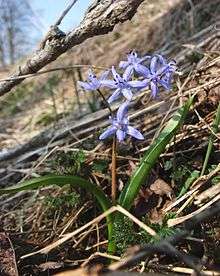Scilla bifolia
Scilla bifolia (alpine squill[1] or two-leaf squill) is a herbaceous perennial growing from an underground bulb,[2] belonging to the genus Scilla of the family Asparagaceae.
| Scilla bifolia | |
|---|---|
 | |
| Scientific classification | |
| Kingdom: | Plantae |
| Clade: | Tracheophytes |
| Clade: | Angiosperms |
| Clade: | Monocots |
| Order: | Asparagales |
| Family: | Asparagaceae |
| Subfamily: | Scilloideae |
| Genus: | Scilla |
| Species: | S. bifolia |
| Binomial name | |
| Scilla bifolia | |
The specific epithet bifolia means "twin leaved".[3]
Description
Scilla bifolia grows from a bulb 1–2 cm (0.4–0.8 in) across.[2] There are two or rarely three lance-shaped, curved, fleshy and shiny leaves[2] and the bases of the leaves clasp up to about the half of the stem (amplexicaul).[2]
The flowering stems are erect and unbranched, 10–20 cm (4–8 in) high.[2] The raceme bears 6-10 flowers, each 1 cm (0.4 in) across.[2]
The flowers of Scilla bifolia are upward-facing, unlike the nodding flowers of Scilla siberica (Siberian squill). They bloom from early to late spring. The six tepals are deep violet-blue, more rarely white, pink, or purple.[2] The fruit is a capsule 6–8 mm (0.2–0.3 in) across.[2]
S. bifolia has gained the Royal Horticultural Society's Award of Garden Merit.[4][5]
.jpg)
Taxonomy
Subspecies
- Scilla bifolia subsp. bifolia
- Scilla bifolia subsp. buekkensis (Speta) Soó
- Scilla bifolia subsp. rara Trávníček
- Scilla bifolia subsp. spetana (Kereszty) Trávníček
- Cultivars
The cultivated variety 'Rosea' has pale pink or white flowers.
Synonyms
Synonyms of Scilla bifolia include:
|
|
Distribution
Scilla bifolia is native to Europe and western Russia south through Turkey to Syria.[6] The plant is found in shady places, woods of beech or deciduous trees, and mountain grasslands.[2] It grows at an altitude of 100–2,000 m (330–6,560 ft) above sea level.[2]
Gallery
 Scilla bifolia plants
Scilla bifolia plants
References
- "BSBI List 2007". Botanical Society of Britain and Ireland. Archived from the original (xls) on 2015-01-25. Retrieved 2014-10-17.
- Pignatti S. - Flora d'Italia - Edagricole – 1982 Vol. III, pg. 365
- Harrison, Lorraine (2012). RHS Latin for gardeners. United Kingdom: Mitchell Beazley. p. 224. ISBN 9781845337315.
- "RHS Plant Selector - Scilla bifolia". Retrieved 3 June 2013.
- "AGM Plants - Ornamental" (PDF). Royal Horticultural Society. July 2017. p. 9. Retrieved 6 November 2018.
- "Scilla bifolia". Germplasm Resources Information Network (GRIN). Agricultural Research Service (ARS), United States Department of Agriculture (USDA). Retrieved 19 January 2018.
- T.G. Tutin, V.H. Heywood et alii, Flora Europaea, Cambridge University Press, 1976
External links
| Wikimedia Commons has media related to Scilla bifolia. |
![]()